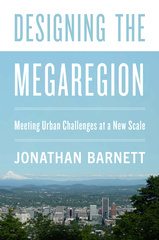208 pages, 6 x 9
25 illustrations, 15 photos
Paperback
Release Date:05 Apr 2016
ISBN:9781610916233
There exists a category of American cities in which the line between suburban and urban is almost impossible to locate. These suburban cities arose in the last half of twentieth-century America, based largely on the success of the single-family home, shopping centers, and the automobile. The low-density, auto-centric development of suburban cities, which are largely in the arid West, presents challenges for urban sustainability as it is traditionally measured. Yet, some of these cities—Los Angeles, Las Vegas, Phoenix, Salt Lake, Dallas, Tucson, San Bernardino, and San Diego—continue to be among the fastest growing places in the United States.
In The Future of the Suburban City, Phoenix native Grady Gammage, Jr. looks at the promise of the suburban city as well as the challenges. He argues that places that grew up based on the automobile and the single-family home need to dramatically change and evolve. But suburban cities have some advantages in an era of climate change, and many suburban cities are already making strides in increasing their resilience. Gammage focuses on the story of Phoenix, which shows the power of collective action — government action — to confront the challenges of geography and respond through public policy. He takes a fresh look at what it means to be sustainable and examines issues facing most suburban cities around water supply, heat, transportation, housing, density, urban form, jobs, economics, and politics.
The Future of the Suburban City is a realistic yet hopeful story of what is possible for any suburban city.
In The Future of the Suburban City, Phoenix native Grady Gammage, Jr. looks at the promise of the suburban city as well as the challenges. He argues that places that grew up based on the automobile and the single-family home need to dramatically change and evolve. But suburban cities have some advantages in an era of climate change, and many suburban cities are already making strides in increasing their resilience. Gammage focuses on the story of Phoenix, which shows the power of collective action — government action — to confront the challenges of geography and respond through public policy. He takes a fresh look at what it means to be sustainable and examines issues facing most suburban cities around water supply, heat, transportation, housing, density, urban form, jobs, economics, and politics.
The Future of the Suburban City is a realistic yet hopeful story of what is possible for any suburban city.
One of the sanest looks at our suburbs.
Makes a case for the sustainability of arid Western cities.
Gammage argues that Phoenix is more sustainable than you might think...Yet, in each chapter, Gammage also highlights many significant challenges facing Phoenix...a well-organized and readable book.
The car, the shopping centre and the single-family home, reveals urban specialist Grady Gammage Jr, created the 'suburban city'...In his study of their potential for sustainable transition, Gammage focuses on Phoenix, Arizona...[arguing] that its historic reliance on renewable surface water rather than groundwater, and openness to low-carbon light transport, point to a potential for future resilience.
For high-carbon American desert cities facing down the fierce impact of climate change, the challenges seem insurmountable, and yet they continue to grow. As a seasoned urban advocate and real estate attorney, Gammage is uniquely positioned to tell us how a thirsty Western giant like Phoenix can become a resilient metropolis in the ever hotter and drier years to come.'
Gammage is one of the few observers of the urban scene that really gets suburban cities. Unlike so many others who negatively judge and chastise suburban cities in the Southwest, Gammage seeks to understand these places on their own terms. This book greatly advances our knowledge of how these places work and shows how suburban cities proved far more resilient and sustainable than critics had expected.
Nobody knows more about Phoenix than Grady Gammage. The Future of the Suburban City is a good yarn about what it has taken to create a postwar Sunbelt metropolis—and what it will take to keep it going.
Grady Gammage, Jr. is a Senior Sustainability Scholar at Arizona State University’s Julie Ann Wrigley Global Institute of Sustainability and Senior Fellow at ASU’s Morrison Institute of Public Policy. He also teaches at the Sandra Day O’Connor College of Law and at the W.P. Carey School of Business at ASU. Gammage is also a practicing lawyer, a real estate developer, and a former elected official.
Table of Contents
Prologue. Getting Through the Haboob
Chapter 1. Suburbs, Sprawl, and Sustainability
Chapter 2. Just Add Water
Chapter 3. Coping with Heat
Chapter 4. Transportation and the Suburban City
Chapter 5. Houses, Shopping Centers, and the Fabric of Suburbia
Chapter 6. Jobs and the Economy of Cities in the Sand
Chapter 7. Politics, Resilience, and Survival
Afterword. Planning to Stay
Prologue. Getting Through the Haboob
Chapter 1. Suburbs, Sprawl, and Sustainability
Chapter 2. Just Add Water
Chapter 3. Coping with Heat
Chapter 4. Transportation and the Suburban City
Chapter 5. Houses, Shopping Centers, and the Fabric of Suburbia
Chapter 6. Jobs and the Economy of Cities in the Sand
Chapter 7. Politics, Resilience, and Survival
Afterword. Planning to Stay




